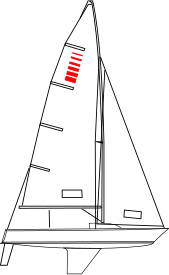Sonar (keelboat)
|
Class symbol
|
|
 |
|
| Crew | 3 or 4 |
|---|---|
| Draft | 1.2 m (3 ft 11 in) |
| Hull weight | 950 kg (2,090 lb) of which 408 kg (899 lb) is ballast |
| LOA | 7 m (23 ft) |
| LWL | 6.1 m (20 ft) |
| Beam | 2.4 m (7 ft 10 in) |
| Spinnaker area | 22.8 m2 (245 sq ft) |
| Upwind Sail Area | 23.2 m2 (250 sq ft) |
| D-PN | 81.0 |
| RYA PN | 940 |
| Paralympics class | |
The Sonar is a 7 m (23 ft) one-design keelboat for three to five people. It is bermuda-rigged, with a large mainsail and a 100% jib. The class is recognised by the International Sailing Federation.
The Sonar showcased disabled sailing at the 1996 Paralympic Games where the sport was a demonstration event with just the Sonar. The Sonar has been the three person keelboat at every subsequent Paralympics. When being sailed by disabled it is crewed by 3, and sailed without a spinnaker. Instead, when running downwind a whisker pole is used to hold the jib out to windward for maximum exposed sail area. The Sonar is well suited for disabled sailing because of its large open cockpit making adaptations easy.
The Sonar was designed in 1979 by Bruce Kirby, designer of the popular Laser dinghy. Since then, over 800 boats have been built. Most of the fleet is in the USA, with smaller fleets in Britain and Canada. Since its adoption as a Paralympic class the Sonar has spread to many other countries as well.
The Sonar was inducted into the American Sailboat Hall of Fame in 2004.
The Sonar has also been used extensively for disabled sailing. The boat specifications are exactly the same for open and disabled sailing events, but additional adaptations are allowed to be fitted to the boat to aid the crew who are not permitted to hike or use a spinnaker. The World Championships is recognised by World Sailing.
The Sonar has been the equipment used for the three person keelboat discipline at every Paralympic Sailing Competition.
...
Wikipedia
